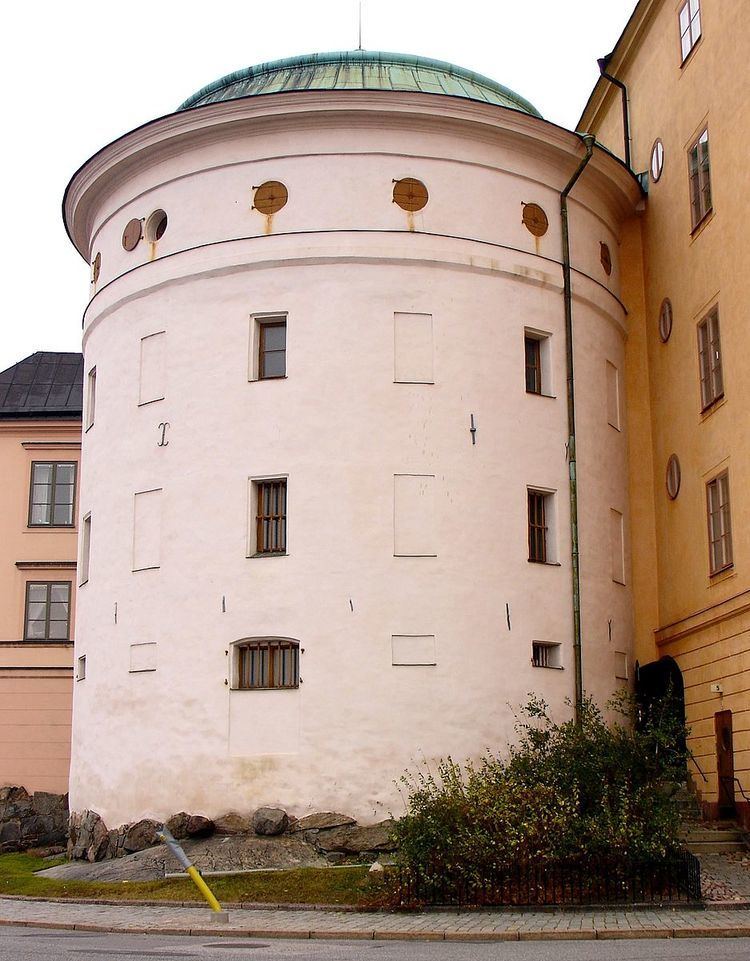 | ||
Similar Riddarholmen, Gamla stan, Wrangel Palace, Sundbyfortet, Västra Arningefortet | ||
Birger jarls torn stockholms ldsta hus riddarholmen stockholm
Birger Jarls torn (Swedish for Birger Jarl's Tower) is a defensive tower on the north-western corner of Riddarholmen, an islet in Gamla Stan, the old town of Stockholm.
Contents
The building is named after Birger Jarl, traditionally attributed founder of Stockholm. However, it was built several hundreds years after the foundation of the city, and the name is mostly the product of a 17th-century myth. Stockholm literally translates to "Log-Islet", and, according to the myth, the city was founded on the location of the tower chosen by a log left drifting in Lake Mälaren.
History
Often mentioned as the oldest building in town, the tower was in fact built by King Gustav Vasa as part of his efforts to reinforce and modernize the fortifications of the capital. It replaced timbered redoubts destroyed by fire in 1525 and is, together with the southern tower of the Wrangel Palace, the only surviving structure of the 16th century defensive system. Originally, a wall connected the two towers.
For the construction bricks were taken from a monastery, St. Clare's Priory near today's Sergels torg (Sankta Klara kloster) destroyed in 1527 and churches from the ridges surrounding the city was used. The building was originally two stories tall with a crenellated top. Towards the waterfront the base of the cavity wall was made very thick — almost 2,5 metres at the base and about 0,75 centimetres at the top — while the other side was considerably thinner with much larger openings. In 1589-1590, the original crenellation was rebuilt into a third floor topped by a cone-shaped roof and the present white grouting was added to the façade.
In the 1620s the king begun to donate lots on Riddarholmen to prominent members of the Swedish nobility, and the islet was gradually transformed into the palace-laden location it still is. From the mid 17th century the tower, at the time called Rundelen (e.g. "the round tower"), was gradually fused with surrounding buildings. It was thoroughly rebuilt in the mid 18th century, the original apertures transformed into windows while a fourth floor topped by a new roof furnished with a gilded sphere was added. Together with the two flanking buildings, the 18th century restoration was mostly likely the design of Carl Hårleman. During the 19th century both the tower and the two flanking buildings were rebuilt many times in order to accommodate various institutions and authorities such as a pawnshop and the city archive. In the 1950s, the entire complex was completely rebuilt again with new concrete joints replacing the old wooden ones while new barred windows and a detached spiral staircase were added.
Before housing the chancellor of justice in 2007, the building was carefully documented and restored in 2006. Some of the more recent addition were subsequently removed while some older, discontinued alternations were reused. All new addition were carefully adopted to the existent structure in order to emphasise the historical values of the building while giving space for modern installations and demands on accessibility. The entire top floor have been transformed into a round conference room with an oval desk surrounded by the round windows. As of 2007, the lower part of the building is intended to house a café, a restaurant, or any similar operation in order to reduce the isolated state of the islet Riddarholmen and make it more attractive to Stockholmers.
